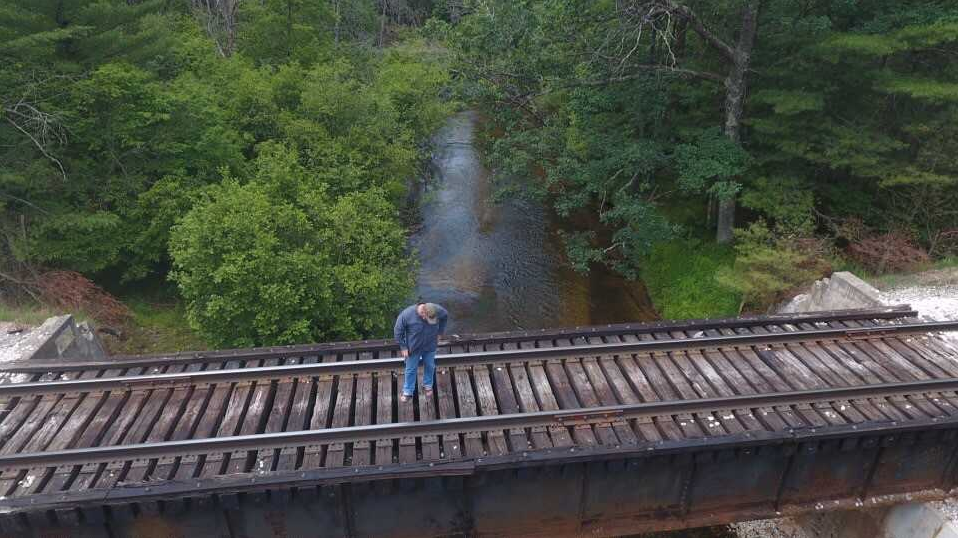The author standing on the railroad bridge where the first brown trout were introduced to America.
By Kirk Deeter
Most anglers have home waters—places they consider sacred. For me, the tracks always lead back to Baldwin, Mich., and the Pere Marquette River system. It was here where I learned to fly fish.
Many years ago, when I was dating my now-wife, Sarah, I figured I would not “make the cut” with her fly-fishing family unless I took up the sport. Her father, Fred Warner, and grandfather, Jack Steketee, became my first fly-fishing mentors, and I still think of them (now both gone) every single time I go fishing. They taught me much more than how to cast, pick flies and fool trout. They taught me that this whole fishing thing is mostly about connections to places and people. It was the most important “fishing” lesson I ever learned.
Perhaps ironically, one of the railroad trestles that span the Baldwin River (effectively the north fork of the Pere Marquette) was the spot where the first brown trout were reportedly planted in the United States in the early 1880s. My first trout on a fly was a brown in the Baldwin, and that same darn fish has now led me on a lifelong odyssey that I might never have imagined—to places like New Zealand, Chile, Argentina, Iceland, Ireland and beyond.
But my answer to the “if you had only one day to fish anywhere” question has never changed. I’d be somewhere in or around Baldwin, from throwing gray drakes at the Clay Banks on the big river, to flicking hoppers in the technical gin-clear pools on the Middle Branch. I think the PM and its tributaries are the ultimate “teaching waters” because they force you to up your game and improvise. They force you to be observant. No different than sacred waters like the North Umpqua in Oregon, or Silver Creek in Idaho, or the Roaring Fork in Colorado, it takes a helluva lot of savvy to trick a 20-inch brown or land a wild steelhead on the PM (and you can do both here).
In the summer, after the Lake Michigan migrators are long gone, you can spend all day casting and catch nothing but dinks. Yet right when you start to wonder if there’s anything larger than the palm of your hand in the river, the sun sets, and the bugs hatch, and all the old, smart fish slink out from under the logjams to feed. They cannot help themselves. And when you see that, you will never be the same angler.
But these are fragile waters. And they need help. Fortunately TU is on the case. We’ve partnered with the Lake County Road Commission to reconnect 6 miles of habitat on the Middle Branch. We’re working with the Forest Service to manage large woody habitat in the main branch of the Baldwin to ensure adequate cover for fish. We’re prioritizing and addressing fish passage issues on the Little South. Most importantly, we’re starting an angler science initiative, recruiting citizen anglers to help us monitor important issues like stream temperatures, habitat, and spawning redds. We need your continued support and involvement, especially if you consider these home waters.
My family hangs our waders in the basement of our cabin on the Baldwin, and nailed to the basement door are plywood fish cut-outs, cut by Grandfather with a jigsaw. They represent actual, enormous trout that he caught on mosquito flies he tied himself, way back in the day. Those shapes haunt me now, every time I wader up to fish, because I have only caught a scant few like that over the years. But enough to know they’re there, and enough to believe what can happen here if anglers stay vigilant.
If I had one dream—so help me, if I could do one thing—through all my conservation advocacy and writing, it would be to ensure these waters held fish worth making silhouette cutouts from, for my great grandchildren to see. Not so much because I wish for them to catch fish like that. This wish is that they too will respect the place, and honor the people who kept it wild.
Kirk Deeter is the vice president of Trout Media. He lives and works in the mountains outside of Denver, but his fly-fishing roots are sunk deep in the Pere Marquette drainage in Michigan.



